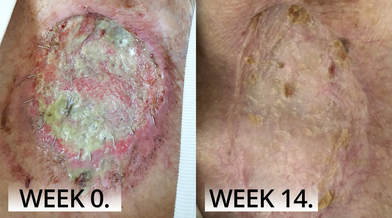
Post-operative wounds in elderly patients with serious comorbidities require precise care in order to ward off infection and ensure that the skin around the wound is properly hydrated while the drainage is managed at the same time.
This case presented a perfect opportunity for Enluxtra dressing to demonstrate its versatility and multi-functionality when used for large surface area wound with skin grafting.
About the patient
The patient was an 89-year-old Caucasian male who underwent an excision of squamous cell carcinoma on his chest with skin grafting. The patient was a former pipe smoker suffering from normocytic anemia, chronic kidney disease, generalized weakness, adrenal insufficiency, hypertension, skin cancer on chest, nose, left ear lobe, malnutrition, low albumin, and first-degree atrioventicular block.
The wound and past treatment
After a follow-up appointment with a surgeon the patient was admitted to the hospital and transfused with 2 units of blood. Foam dressing was applied on his chest wound. Patient was admitted to home health services in the next week with orders to dress surgical wound with foam dressing, covered with an ABD pad dressing and secured with tape. NPWT unit was in place to midline upper chest at admission. Large amounts of drainage noted in the unit’s canister, very odorous within 3 feet.
Enluxtra dressing treatment progress
Enluxtra dressing advantages were discussed with the patient’s MD and the treatment was started with dressing changes twice a week. The wound displayed rapid progress toward closure and was 50% epithelialized in a matter of 3 weeks. Odor was greatly reduced by the end of week 1, pain disappeared by the end of second week.
After 5 weeks the wound was mostly closed and remained so at the 14 week follow-up visit.
Clinical conclusions
This large wound started out as a non-healing, highly draining and painful sore vulnerable to infection with questionable prospects of the applied skin graft.
Enluxtra treatment resolved maceration, provided hydration support to the fragile tissues, cleared the wound bed in record time without desiccating it, and protected the entire wound site from infection.
It also provided much needed pain relief without additional medication.
Patients of advanced age whose skin has lost elasticity and other barrier properties benefit greatly from a smart polymer action of Enluxtra dressing that responds to the needs of each tissue type in real time.
Scroll down to view photos of wound progress and clinical notes.
Learn more about Enluxtra
This case presented a perfect opportunity for Enluxtra dressing to demonstrate its versatility and multi-functionality when used for large surface area wound with skin grafting.
About the patient
The patient was an 89-year-old Caucasian male who underwent an excision of squamous cell carcinoma on his chest with skin grafting. The patient was a former pipe smoker suffering from normocytic anemia, chronic kidney disease, generalized weakness, adrenal insufficiency, hypertension, skin cancer on chest, nose, left ear lobe, malnutrition, low albumin, and first-degree atrioventicular block.
The wound and past treatment
After a follow-up appointment with a surgeon the patient was admitted to the hospital and transfused with 2 units of blood. Foam dressing was applied on his chest wound. Patient was admitted to home health services in the next week with orders to dress surgical wound with foam dressing, covered with an ABD pad dressing and secured with tape. NPWT unit was in place to midline upper chest at admission. Large amounts of drainage noted in the unit’s canister, very odorous within 3 feet.
Enluxtra dressing treatment progress
Enluxtra dressing advantages were discussed with the patient’s MD and the treatment was started with dressing changes twice a week. The wound displayed rapid progress toward closure and was 50% epithelialized in a matter of 3 weeks. Odor was greatly reduced by the end of week 1, pain disappeared by the end of second week.
After 5 weeks the wound was mostly closed and remained so at the 14 week follow-up visit.
Clinical conclusions
This large wound started out as a non-healing, highly draining and painful sore vulnerable to infection with questionable prospects of the applied skin graft.
Enluxtra treatment resolved maceration, provided hydration support to the fragile tissues, cleared the wound bed in record time without desiccating it, and protected the entire wound site from infection.
It also provided much needed pain relief without additional medication.
Patients of advanced age whose skin has lost elasticity and other barrier properties benefit greatly from a smart polymer action of Enluxtra dressing that responds to the needs of each tissue type in real time.
Scroll down to view photos of wound progress and clinical notes.
Learn more about Enluxtra
- View Enluxtra case studies to see how it can heal the most difficult, stubborn wounds that resisted previous treatment with other products.
- Find out about Enluxtra difference.
- To buy Enluxtra dressings visit our online store, or explore other purchasing options.
- Order free samples available to medical professionals.
- Read other posts in our blog.
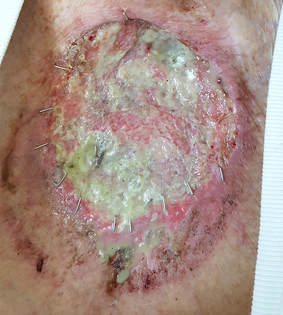
Week 0.
The wound measures 10 cm x 11.5 cm x 0.5 cm, (115 sq. cm), closed surgical dressing with 12 staples in place, copious purulent light green drainage, strong odor, non-healing, 75% slough, surrounding skin macerated.
The wound measures 10 cm x 11.5 cm x 0.5 cm, (115 sq. cm), closed surgical dressing with 12 staples in place, copious purulent light green drainage, strong odor, non-healing, 75% slough, surrounding skin macerated.
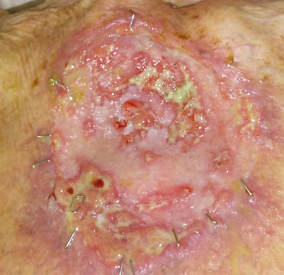
Week 1.
Wound size is 7.4cm x 6.6cm x 0.3cm. Moderate amount of purulent drainage, faint odor, 50% slough, no maceration, normal periwound skin color, 25% epithelialization.
Wound size is 7.4cm x 6.6cm x 0.3cm. Moderate amount of purulent drainage, faint odor, 50% slough, no maceration, normal periwound skin color, 25% epithelialization.
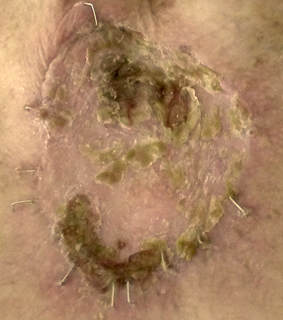
Week 3.
The wound measures 6.3cm x 5.8cm x 0.2cm. Small amount of purulent drainage, 25% slough, no periwound maceration evident, surrounding skin normal color, no induration, no pain, no odor, 50% epithelialization.
The wound measures 6.3cm x 5.8cm x 0.2cm. Small amount of purulent drainage, 25% slough, no periwound maceration evident, surrounding skin normal color, no induration, no pain, no odor, 50% epithelialization.
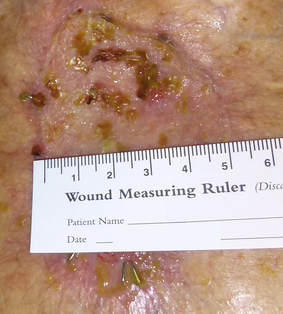
Week 5.
Wound measurements are 6.3cm x 5cm x 0.1cm. Very small amount of drainage, less than 25% slough, peri-wound skin is healthy, no odor, 75% epithelialization.
Wound measurements are 6.3cm x 5cm x 0.1cm. Very small amount of drainage, less than 25% slough, peri-wound skin is healthy, no odor, 75% epithelialization.
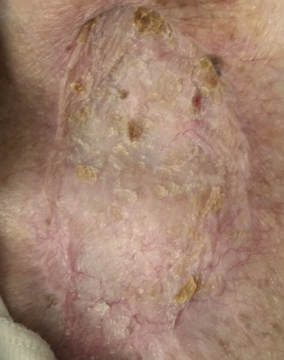

 RSS Feed
RSS Feed
